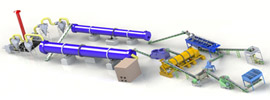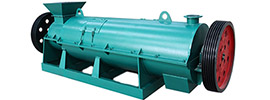For small-scale farms, the resourceful utilization of manure is a pivotal strategy to mitigate environmental pollution, reduce operational costs, and generate supplementary income. Through scientific processing and technological conversion, manure can be transformed into high-value products such as organic fertilizers, energy, and feed, forming a closed-loop ecological chain of "farming-processing-utilization." Below is a detailed plan and implementation guide for resource utilization:
1. Organic Fertilizer Production: Soil Enrichment and Agricultural Value Addition
A. Aerobic Composting Technology
- Process Flow:
- Raw Material Mixing: Combine manure with auxiliary materials (straw, wood chips, rice husks) in a 3:1 ratio, adjusting moisture content to 55%-65% and carbon-to-nitrogen (C/N) ratio to 25-30:1.
- Composting: Form windrows (1.5-2 meters high, 2-3 meters wide) and aerate regularly (every 3-5 days) to ensure oxygen supply.
- Maturity Criteria: Maintain temperatures at 55-65°C for over 15 days until the compost turns dark brown, odorless, and achieves ≤30% moisture content.
- Product Upgrades:
- Introduce functional microbial agents (e.g., phosphate-solubilizing bacteria, Bacillus subtilis) to produce specialized fertilizers, increasing market value by 30%-50%.
- Pelletize for easier transportation and application, commanding premium prices.
B. Vermicomposting (Biological Processing)
- Technical Essentials:
- Use Eisenia fetida worms, mixing manure with auxiliary materials in a 1:1 ratio at 20-25°C and 60%-70% humidity.
- Stocking density: 10,000-20,000 worms/m², with a 60-day conversion cycle.
- Product Value:
- Worms: High in crude protein (60%-70%), suitable for aquaculture or pet food.
- Worm Castings: Organic matter ≥45%, valued at RMB 400-600/ton, ideal for premium horticulture.
- Benefits:
- 1 ton of manure yields 150-200 kg worms and 300-400 kg castings, totaling over RMB 2,000 in revenue.
2. Biogas Engineering: Energy Conversion and Clean Production
A. Biogas Fermentation Systems
- Design Considerations:
- Digester Types: Recommend water-pressure biogas digesters (10-30 m³) or FRP tanks for cost efficiency.
- Feedstock Ratio: Mix manure with water (1:1) and inoculate with 10%-20% effluent for accelerated gas production.
- Operating Conditions: 25-35°C, pH 6.8-7.5, and 20-30 days retention time.
- Product Utilization:
- Biogas: For cooking, heating, or power generation (1 m³ biogas = 1.5-2 kWh electricity), reducing fuel costs by over 50%.
- Digestate: Use as base fertilizer or foliar spray, cutting chemical fertilizer use by 30%-50%.
- Case Study:
- A pig farm in Hunan processes 360 tons of manure annually via a 20 m³ digester, producing 2,000 m³ biogas to meet the energy needs of 10 households.
B. Biogas Upgrading to Bio-CNG
- Technical Pathway:
- Purify biogas via membrane separation or water scrubbing to achieve ≥95% methane concentration, suitable for vehicle fuel or grid injection.
- Price: 3-5 times higher than raw biogas.
- Applicable Scenarios:
- Large-scale farms (≥100 m³/day biogas) or regional biogas supply projects.
3. Insect Protein Conversion: High-Value Feed Production
A. Black Soldier Fly Farming
- Technical Workflow:
- Larval Inoculation: Mix manure with wheat bran (3:1) and inoculate with 3-day-old larvae at 2,000 larvae/kg.
- Rearing Management: Maintain 25-30°C, 60%-70% humidity, harvesting at 8-10 days (larval weight ≥0.2 g).
- Separation: Screen larvae from frass; dry or sell fresh larvae, and compost frass.
- Economic Returns:
- 1 ton of manure yields 150-200 kg larvae and 300-400 kg frass.
- Market Applications:
- Larvae as premium aquaculture feed; frass for organic vegetable cultivation.
B. Housefly Farming
- Technical Essentials:
- Rear maggots on manure, yielding 100-150 g maggots/kg manure (50%-60% crude protein).
- Extract chitin from defatted maggots for pharmaceutical or food additive use.
4. Eco-Circular Models: Integrated Farming and Industry Synergy
A. Pig-Biogas-Fruit (Vegetable) Model
- Mechanism:
- Manure → Biogas digesters → Digestate → Orchards/fields → Fruits/vegetables → Market sales.
- Drip irrigation with digestate reduces nutrient loss and enhances crop quality.
B. Chicken-Insect-Forest Model
- Mechanism:
- Chicken manure → Black soldier fly farming → Larvae fed to chickens → Frass for fast-growing trees (e.g., eucalyptus).
- Creates a "livestock-insect-plant", reducing feed costs by 20%-30%.
5. Branding Strategies
- Certifications:
- Apply for organic or green food certifications to command 20%-50% price premiums.
- Sales Channels:
- E-commerce platforms, agro-input dealers, or direct cooperative supplies.
Conclusion
Small-scale farms must adhere to the principles of "reduction, harmlessness, and resourcefulness" in manure utilization, aligning with their scale, technical capacity, and market demands. Key strategies include:
- Technological Upgrading: Adopt advanced processes like aerobic composting and insect farming to enhance product value.
- Model Innovation: Develop integrated eco-circular systems to reduce costs.
- Policy Leverage: Maximize subsidies and carbon trading revenues.
- Branding: Build premium products via certifications and e-commerce channels.
By systematically implementing resource utilization, small-scale farms can transform manure from a pollutant into a profit center, achieving dual wins in environmental and economic benefits.
 Send us a Email
Send us a Email Wulong Industrial Cluster
Wulong Industrial Cluster Have any question?
Have any question?



















